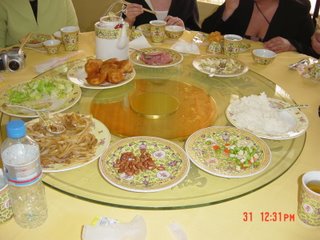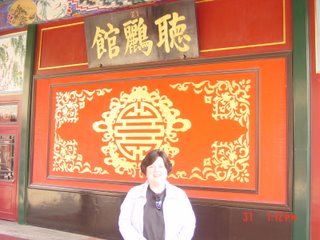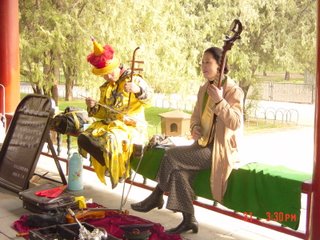Two days until we get Cao Ai Hua
By Terry R. Cassreino
BEIJING - You think Hattiesburg’s traffic is bad since Hurricane Katrina added 10,000-plus people to the city’s population?
Well, come on over here to Beijing, a city of 18 million people who live in 5,000 square miles of space and drive at least 1,000 cars a day into town.

Come visit one of the largest cities in China where people drive cars and busses without regard to striped lanes on streets, traffic signs and stop lights.
Come visit Beijing where, as one family about to adopt a child put it, motorists participate in controlled chaos.
And you know what? Chaos is an accurate description for a town in which it takes a taxi ride of 30 minutes or more to reach the other side.
Pam and I have held our breath often during the several taxi and bus trips from the hotel to shopping and tourist areas.
Drivers will cut in front of you for no reason. Motorists weave in-and-out of expressway laness without regard to other people.
And traffic throughout town is often at a standstill just about every hour of the day. Vehicles often creep along at 10 mph to 15 mph or less.
I have yet to see any road rage - and I hope I don’t. To be honest, I don’t know if I could hold out for a long time if I had to drive in this day-in and day-out.
Eating in China
The food.
You haven't had Chinese food until you've had Chinese food.
Chinese restaurants in the United States water-down their dishes. While some dishes are spicy back home, many don't have the same strong, pungent flavors, aroma and taste you find here in China. These dishes pack a serious punch.
 Pam and I have eaten at our hotel in Beijing. We just don't know much about the city and don't feel comfortable heading out on our own to some of the neighborhood restaurants (unlike Mexico and Central America, which we have visited more often).
Pam and I have eaten at our hotel in Beijing. We just don't know much about the city and don't feel comfortable heading out on our own to some of the neighborhood restaurants (unlike Mexico and Central America, which we have visited more often).The few restaurants we've visited in town ddn't look as nice as the ones in the hotel. So we have stayed here to eat.
That said, the Kunlun Hotel doesn't skimp when it comes to food. This place has separate Indian, Japanese, Korean and Thailand restaurants. And it also has three Chinese restaurants, each with its own distinct regional menus.
So Friday night Pam and I had fried pork with vegetables and fried rice with egg. The pork dish was a bit spicy and unlike anything we have eaten at China Buffet or Mandarin House in Hattiesburg. The fried rice wasn't even like the fried rice you get in the United States.
On Thursday night we had Peking Duck, although here it is called roasted duck. This dish included slices of roasted duck you place on a pancake along with cucumber and a sweet brown sauce, roll it up and eat it. Incredible.

Breakfast at the hotel is a veritable feast with scrambled eggs; huge slabs of fresh bacon; seasoned hash browns; sushi (yes, sushi); a fried pastry that tastes like a beignet but lacks the powdered sugar; cooked-to-order omelets; assorted pastries; and any kind of fresh juice you want.
As part of our tour to the Summer Palace on Friday, we ate at a restaurant on the site. While the food was excellent, our guide said it was Americanized Chinese food to appease our tastes. I thought so. It didn't look or taste like the food at our hotel.
Other observations
- Where are the strays? We've been here since Tuesday night, have taken taxis all over town and have seen things we've never seen before. But one thing struck me last night: We haven't seen any stray dogs or cats.
- Bikes. I have never seen so many bicycles in my life. I guess not all of the 18 million Beijing residents drive a car (althought it certainly seems that way everyday we hit the streets). The city even has a specified bike lane on streets for bicycle traffic.
- The Silk Market in Beijing is incredible. Five floors with hundreds of individually rented booths selling everything from clothes (supposedly name brand U.S. clothes), jewelry and rugs to electronics and watches. But the salespeople won't take no for answer. If you visit their store they'll block you in and grab you by the arm until you buy their merchandise. These are aggressive salesmen.
- The city is booming with construction, with cranes all over the place and work being done 2
 4 hours a day. But many of the seemingly endless rows of skyscrapers practially look the same. And mixed among the newer apartment buildings are much older, unkempt ones.
4 hours a day. But many of the seemingly endless rows of skyscrapers practially look the same. And mixed among the newer apartment buildings are much older, unkempt ones.
Preparations continue
In between all of this, Pam and I are still preparing for Monday. We still have to buy small gifts for the baby's caregivers and the head of the orphanage where Cao Ai Hua lives. We'll probably swing over to Wal-Mart to find something.
Then it's back to the documents. We have a briefing Sunday with Holt officials, so we hope to finalize all of our preparations today on Sunday (although I'm sure I'll have new documents to complete once we reach Nanchang on Monday).
Our tour guide with Lotus Travel told Pam that we might even be able to visit Cao Ai Hua's orphanage next week.
Text and photos copyright 2006 by Terry R. Cassreino

No comments:
Post a Comment